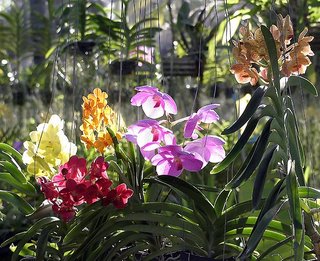
Orchids
Orchids ( Orchidaceae family ) are the largest and most diverse of the flowering plant (Angiospermae) families, with over 800 described genera and 25,000 species. Some sources give 30,000 species, but the exact number is unknown since classification differs greatly in the academic world. Revisions of different genera occur on a monthly basis and this will increase with the growing use of genetic research and biochemistry. There are another 100,000+ hybrids and cultivars produced by horticulturists, created since the introduction of tropical species in the 19th century. The Kew World Checklist of Orchids includes about 24,000 accepted species. About 800 new species are added each year. Orchids, through their interactions with pollinators and their symbiosis with orchid mycorrhizal fungi, are considered by some, along with the grasses, to be examples of the most advanced (derived) floral evolution known.
All orchid species are protected for the purposes of international commerce under CITES as potentially threatened or endangered in their natural habitat, with most species listed under Appendix II. A number of species and genera are afforded protection under Appendix I, including all of Paphiopedilum and all of Phragmipedium. Many other species are protected by both international and national legislation, while hybrids are specifically exempted.
The structure of the leaves corresponds to the specific habitat of the orchid. Species that typically bask in sunlight, or grow on sites which can be occasionally very dry, have thick, leathery leaves. The laminas are covered by a waxy cuticle. These retain their necessary water supply. Shade species, on the other hand, have tall, thin leaves. They cannot tolerate a drop in atmospheric humidity or exposure to direct sunlight. Between these two extremes, there is a whole range of intermediate forms.
All orchid species are protected for the purposes of international commerce under CITES as potentially threatened or endangered in their natural habitat, with most species listed under Appendix II. A number of species and genera are afforded protection under Appendix I, including all of Paphiopedilum and all of Phragmipedium. Many other species are protected by both international and national legislation, while hybrids are specifically exempted.
Naming
Orchids get their name from the Greek orchis, meaning "testicle", from the appearance of subterranean tuberoids of the genus Orchis. The word "orchis" was first used by Theophrastos (372/371 – 287/286 BC), in his book "De historia plantarum" (The natural history of plants). He was a student of Aristotle and is considered the father of botany and ecology.Leaves
Orchid have leaves with parallel veins like any monocotyledon. Their size and shape can be an aid in identifying the orchid, since it reflects the taxonomic position.The structure of the leaves corresponds to the specific habitat of the orchid. Species that typically bask in sunlight, or grow on sites which can be occasionally very dry, have thick, leathery leaves. The laminas are covered by a waxy cuticle. These retain their necessary water supply. Shade species, on the other hand, have tall, thin leaves. They cannot tolerate a drop in atmospheric humidity or exposure to direct sunlight. Between these two extremes, there is a whole range of intermediate forms.
Root
Orchids Cypripedium species like Oncidium and Dendrobium only having root hair meanwhile monopodial vanda having hair root and aerial roots entirely above the ground.








1 comment:
You have wonderful pictures.
Post a Comment